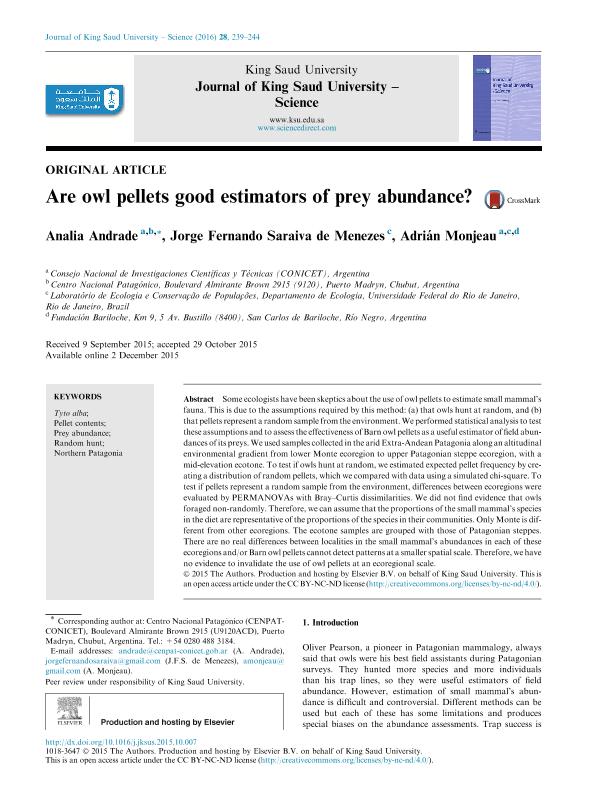Mostrar el registro sencillo del ítem
dc.contributor.author
Andrade, Analia

dc.contributor.author
Menezes, Jorge Fernando Saraiva de
dc.contributor.author
Monjeau, Jorge Adrian

dc.date.available
2019-08-07T19:31:01Z
dc.date.issued
2016-07
dc.identifier.citation
Andrade, Analia; Menezes, Jorge Fernando Saraiva de; Monjeau, Jorge Adrian; Are owl pellets good estimators of prey abundance?; Elsevier B.V.; Journal of King Saud University - Science; 28; 3; 7-2016; 239-244
dc.identifier.issn
1018-3647
dc.identifier.uri
http://hdl.handle.net/11336/81136
dc.description.abstract
Some ecologists have been skeptics about the use of owl pellets to estimate small mammal's fauna. This is due to the assumptions required by this method: (a) that owls hunt at random, and (b) that pellets represent a random sample from the environment. We performed statistical analysis to test these assumptions and to assess the effectiveness of Barn owl pellets as a useful estimator of field abundances of its preys. We used samples collected in the arid Extra-Andean Patagonia along an altitudinal environmental gradient from lower Monte ecoregion to upper Patagonian steppe ecoregion, with a mid-elevation ecotone. To test if owls hunt at random, we estimated expected pellet frequency by creating a distribution of random pellets, which we compared with data using a simulated chi-square. To test if pellets represent a random sample from the environment, differences between ecoregions were evaluated by PERMANOVAs with Bray–Curtis dissimilarities. We did not find evidence that owls foraged non-randomly. Therefore, we can assume that the proportions of the small mammal's species in the diet are representative of the proportions of the species in their communities. Only Monte is different from other ecoregions. The ecotone samples are grouped with those of Patagonian steppes. There are no real differences between localities in the small mammal's abundances in each of these ecoregions and/or Barn owl pellets cannot detect patterns at a smaller spatial scale. Therefore, we have no evidence to invalidate the use of owl pellets at an ecoregional scale.
dc.format
application/pdf
dc.language.iso
eng
dc.publisher
Elsevier B.V.

dc.rights
info:eu-repo/semantics/openAccess
dc.rights.uri
https://creativecommons.org/licenses/by-nc-nd/2.5/ar/
dc.subject
Northern Patagonia
dc.subject
Pellet Contents
dc.subject
Prey Abundance
dc.subject
Random Hunt
dc.subject
Tyto Alba
dc.subject.classification
Ecología

dc.subject.classification
Ciencias Biológicas

dc.subject.classification
CIENCIAS NATURALES Y EXACTAS

dc.title
Are owl pellets good estimators of prey abundance?
dc.type
info:eu-repo/semantics/article
dc.type
info:ar-repo/semantics/artículo
dc.type
info:eu-repo/semantics/publishedVersion
dc.date.updated
2019-06-12T20:07:57Z
dc.journal.volume
28
dc.journal.number
3
dc.journal.pagination
239-244
dc.journal.pais
Países Bajos

dc.conicet.avisoEditorial
This is an open access article under the CC BY-NC-ND license (http://creativecommons.org/licenses/by-nc-nd/4.0).
dc.description.fil
Fil: Andrade, Analia. Consejo Nacional de Investigaciones Científicas y Técnicas. Centro Científico Tecnológico Conicet - Centro Nacional Patagónico; Argentina
dc.description.fil
Fil: Menezes, Jorge Fernando Saraiva de. Universidade Federal do Rio de Janeiro; Brasil
dc.description.fil
Fil: Monjeau, Jorge Adrian. Universidade Federal do Rio de Janeiro; Brasil. Fundación Bariloche; Argentina. Consejo Nacional de Investigaciones Científicas y Técnicas; Argentina
dc.journal.title
Journal of King Saud University - Science
dc.relation.alternativeid
info:eu-repo/semantics/altIdentifier/doi/https://doi.org/10.1016/j.jksus.2015.10.007
dc.relation.alternativeid
info:eu-repo/semantics/altIdentifier/url/https://www.sciencedirect.com/science/article/pii/S1018364715000993
Archivos asociados
